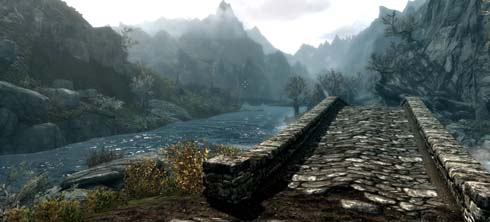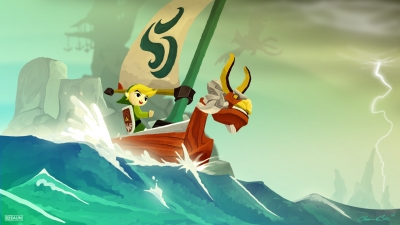Constructing an Attention-Getting Trap
The final part of this IGS project is an “instruction manual” for the construction of attention-getting traps in the same style as Shadow of the Colossus. If you have not yet seen the analysis videos, you may want to review them before continuing. Shadow of the Colossus is, in a similar fashion to a ‘cult film’, a kind of ‘cult game’, with a relatively small but dedicated following. Despite having a relatively small following, it is continually viewed as an essential part of modern video-game canon, and thus has also captured the attention of a much wider audience, leading to those who in the video game industry who have not played the game to know and admire the game for its merits. We have looked at how it does this. How would one replicate its effect?
Creating the Space
As discussed in the analysis, when it comes to spaces, Shadow of the Colossus really wants you to look at the game, and to enjoy its nature. This is pretty common in games these days; a lot of effort is put into making the game experience as realistic and immersive as possible. In a medium that only thirty years ago was limited to the sophistication of Pac-Man, any advances in these areas—which occur yearly—are very noticeable, especially with regards to graphical capabilities. Adding so much detail to such a large world causes players to pause and look at a game for its beauty. Recreating this successfully would require a world for the player to explore that is intriguing to the eyes of the player, causing them to wish to see more of the land, such with The Elder Scrolls series. This is the syntax of the space, which as we mentioned, corresponds to ‘life as information’ in Lanham’s matrix.
 The expansive world of Skyrim is both mysterious and inviting to adventurous players.
The expansive world of Skyrim is both mysterious and inviting to adventurous players.
Unlike The Elder Scrolls, however, Shadow of the Colossus does not nag or cajole the player into continuing the game. If you wander off to do something that has nothing to do with the plot, the game will let you, and it lets you know from the beginning that as soon as you are ready to continue, you can lift your sword to the light and ride straight back into the narrative. The extracurricular nature of the exploration is part of the appeal; you’re finding things that not everybody may find.
That said, the landscape is clearly intentional, unlike, say, Minecraft, where the landscape is detailed and expansive, but not designed by an intelligence. It has no real semantics, it is not a puzzle to be solved. So besides providing a ‘physical’ space to explore, Shadow of the Colossus provides a semantic space to explore. The semantics of the space correspond to ‘life as drama’ in Lanham’s matrix.
Finally, it would be remiss to discuss the landscape of the game without mentioning its most salient feature: the evocativeness of the landscape. It is often the first thing that someone mentions about the game, the feeling of your own personal smallness, as Wander is contrasted with the majesty of the landscape and the bulk of (most of) the colossi. The game Journey does the same. In Journey, the player controls a small person in a robe as they trek across a vast desertscape. The player keeps coming back not just because it entertained them or challenged them, but because the game places them in an emotional space and lets them wander through it, just as it does the ‘physical’ space of the game.
The Player in the Space
Immersion is central to the design of video games, and Shadow of the Colossus is no exception. For a game, the question of immersion is a question of maintaining the agency and identity of the player in the game space. In traditional media, identity is maintained by making the protagonist someone that the reader can identify with, though they must still have some character of their own to present a compelling story. However, with the addition of the player’s agency, this is less necessary—the game can simply project the player into the game spaces as directly as possible. This is accomplished by inviting the perceiver to look through those projective elements, rather than at them. One of the most salient projective elements is the near-silent protagonist. This is not uncommon in games; Half-Life, Dead Space, Portal, the Legend of Zelda series, Halo—are all famous for having completely silent protagonists, and that is not nearly an exhaustive list. By unifying both the agency and identification of the player and the protagonist, the player is encouraged to look put themselves into the role of the protagonist, filling the shoes of a hero.
 Link, the fearless protagonist of the Legend of Zelda series, has said next to nothing in his 28 year legacy, but the hollowness of Link has allowed millions of gamers to see themselves as the true adventurers in the games, becoming the largest draw factor for the series.
Link, the fearless protagonist of the Legend of Zelda series, has said next to nothing in his 28 year legacy, but the hollowness of Link has allowed millions of gamers to see themselves as the true adventurers in the games, becoming the largest draw factor for the series.
Overall, gamers seem to appreciate this; nobody complains when a game has a silent protagonist, while everyone complains when a game features an excess of long, uninterruptible cutscenes and animations which force them to disconnect from the protagonist and break immersion. This works on the same way that fantasy literature often works, as players (or readers), rather than viewing the protagonist as a separate entity, view the protagonist as themselves in the world, committing these heroic deeds, essentially escaping the world of the mundane. Recreating this has been done for generations in the video game industry, and has become one of the signature schemes of the medium.
Furthermore, anyone who plays games is often required to be come familiar with the controls at a near-reflexive level, and with every game having slightly different controls, the gamer is forced to become a connoisseur of interaction. This sets games apart from media such as books or films, where there is only one widely-used interaction mode which rapidly fades into the background. Because the mode of interaction is so close to the attention, its quality can make or break a game. First-person-shooters and racing games, for example, enjoy wide popularity, with easy-to-understand controls. Real-time-strategy games, on the other hand, can have control schemes ranging from complicated to byzantine. These interaction schemes are the nuts and bolts of projecting the player’s agency into the game spaces, and as such, are a powerful tool for allegorizing the nature of the game space. Shadow of the Colossus does this by using simple and direct controls. The realistic mechanisms of climbing and of riding Agro make the game come alive for the players.
Action in the Space
As mentioned, the game does not constantly prod the player forward. If this is the case, what provides the motive to finish the game? In the case of most games, the answer to this is “because it is fun,” and the generation of ‘fun’ provides the impetus to go forward. This seems like an obvious thing to say, but there are a few games which eschew fun as the core motivator, such as Depression Quest, which asks you to continue playing because it is trying to tell you something important, and Super Meat Boy, which is often so pointlessly infuriating that the player wants to quit, except that the game lets you succeed, or get close to succeeding, just enough that continuing becomes a matter of honor, like a cat chasing a string. Looking at these is important, because Shadow of the Colossus does neither. It provides ‘fun’ in the more traditional mode, by giving the player a reasonable-seeming challenge and letting them surmount it. On our motive spectrum, this corresponds to the ‘play’ end. The player also continues playing because there is a story to hear, a more purposeful mode of interaction, though this purposefulness is, to an extent, incident to the game, providing a structure for the space more than anything else. Journey does something similar, with a narrative structure focused mostly on providing a premise for the play space.
 Journey’s world is both epic and immersive. Rather than competing against other players, gamers are encouraged to work together to complete the task of reaching the sacred mountain. Creating this type of world embraces the play portion of the Motive Spectrum.
Journey’s world is both epic and immersive. Rather than competing against other players, gamers are encouraged to work together to complete the task of reaching the sacred mountain. Creating this type of world embraces the play portion of the Motive Spectrum.
The Game Gestalt
In review, here are the core techniques that Shadow of the Colossus uses. It has straightforward, immersive controls. It has an environment which is not only aesthetically appealing, but cognitively appealing and emotionally impactful. It uses a silent protagonist to maximize the agency and identity, and therefore immersion, of the player as themselves. And it provides enough challenge to constitute active gameplay and adequately express that agency.
Taken together, these features form a very paratactical style of rhetoric, where the consumer is left to provide much of the meaning. It’s not a sandbox, where the player is left to find their own meaning entirely; but nor is it engaging in hypotaxis, and supplying all of the meaning for itself.
Further, Shadow of the Colossus uses the video-game equivalent of high style, in that it takes advantage of modern graphics; it takes a serious tone; and it employs the trappings of traditional fantasy (such as constructed languages and mythologies) in their original vein. This is important, since a use of low style could undermine the effect of the game if not pursued properly. Take Super Meat Boy or Minecraft, for example, which utilize retro or pseudo-retro graphics in a form of low style which is firmly tongue-in-cheek, exploiting the intrinsic comedy of the older symbologies of video gaming in a fashion totally unsuited to a game like Shadow of the Colossus.
Shadow of the Colossus utilizes the hypotaxis and high style not just to tell a story, but to evoke a raw emotional response. This emotionality is the core of any effective attention-getting trap, and this particular combination forms the cognitive framework around which the rest of the game is built.